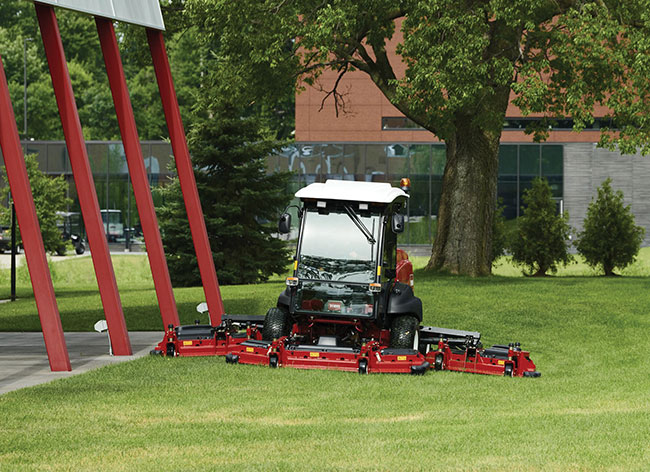
Features
Agronomy
Maintaining sports turf in summer heat
Sports turf managers can’t control temperatures, but they can control how they manage turf in hot weather
June 25, 2021 By Boyd Montgomery

In the summertime, when the weather is hot, drought, heat and disease unite to wreak havoc on sports fields everywhere. As temperatures rise and dry conditions set in, sports turf managers can count on increased stress on cool season grasses.
While you can’t control the temperature, you can control how you maintain your athletic field surfaces to minimize summer stress. Read on to discover the impact of heat stress and how you can encourage turf health in hot weather.
Understanding heat stress & dormancy
Cool season turfgrasses are happiest when soil temperatures are between 50 and 65 degrees Fahrenheit and daytime temperatures stay within 60 to 75 degrees Fahrenheit. But, when temperatures start to rise and soil temperatures increase, heat builds up in the turfgrass and creates stressful conditions.
Root systems are vital to the water and nutrient uptake of the turfgrass, and their growth is particularly impacted by rising summer temperatures. Well before you’ll see the visible effects of turf heat stress, root growth decline will be taking place below the surface. Add the foot traffic common to any athletic field in the summer, and you could quickly be dealing with serious issues.
In addition to summer stress, your turf may experience heat-induced dormancy. When cool season grasses are exposed to long periods of high temps and low moisture, they will stop growing and turn brown. Don’t worry, the plants aren’t a total loss – when daytime temperatures drop down in the fall, moisture will return, and growth will start again. To ensure dormancy is reversed, continue to lightly and frequently irrigate in the summer months to prevent irreversible damage.
It’s always smart to reduce traffic on any turf experiencing heat stress or dormancy to avoid added injury. Don’t drive mowers on a dormant field, and limit foot traffic on stressed turf, if possible.
Watering best practices
To mitigate heat stress, ensure your turf is irrigated with at least one inch of water per week. Watering should occur in the mornings, when temperatures and evaporation rates are lower. Pay attention to particularly hot stretches of weather – extreme heat will cause evaporation rates to increase, which will need to be countered by increased irrigation frequency.
Be careful of overwatering, however, as too much water can sometimes be worse than too little. Remember that shaded turf requires nearly half as much water as grass that receives full sun. For best irrigation results, pay close attention to soil moisture levels and keep a solid record book. Staying alert to the conditions of your turf will help you maintain the correct soil moisture and combat stress.
Mowing in the heat
In the height of the summer months, re-evaluate your mowing schedule. Don’t mow when temperatures are high in the middle of the afternoon, and reduce mowing frequencies wherever possible. If the schedule of play allows it, you may even consider skipping a mowing interval altogether.
Also consider increasing your cut height to help protect turf from stress and encourage growth. Taller turf can also help keep soil temperatures lower at the surface. Keep in mind that a clean cut is essential to the health of your turfgrass, so ensure your mower blades are always sharp. Mowers that feature high-strength steel blades will help you achieve that clean, high-quality cut.
Stay alert
Keeping an eye on the condition of your turf means more than just maintaining proper soil moisture. You should also be monitoring your soil fertility levels, as proper fertilization will help turf fight back against high temperatures. A simple soil test will tell you if you’re in good shape, or if you need to explore increasing or supplementing your fertilization process.
When evaluating your fertilization needs in the beginning of the summer season, remember that an even application is key to maximizing nutrient absorption. Use a turf sprayer which offers exceptional spray accuracy and delivers a consistent, even spray across the turf for optimal fertilization consumption.
While most turf damage will be obvious in the summer, insect damage and disease may be disguised in brown or wilted blades. Be sure to frequently inspect for insects and symptoms of disease and treat any infestations or issues accordingly.
Finally, keep an eye out for weeds, which will compete with your turfgrass plants and make it more difficult for them to stand up to increased stress. Eliminating unwanted weeds immediately increases the moisture and nutrients available to your turf.
Avoid heat stress next summer
Now that we’ve covered how to manage heat stress this summer, don’t wait to look ahead to next year. Encouraging root growth with topdressing and aeration in the spring will help guard against summer stress. Another easy trick to develop strong root systems is raising mower blade heights, as longer blades have deeper root systems for increased water and nutrient uptake.
In some instances, you may also want to consider putting turf through drought conditions with deficit irrigation in the springtime, so the turfgrass plants are preconditioned. This approach facilitates deep rooting as well as water retention.
Though you can’t control the weather, a good preparation plan in the spring and a smart maintenance response in the summer will ensure healthy turfgrasses capable of surviving the summer season.
Boyd Montgomery is regional business manager, North America, for The Toro Company.
Print this page